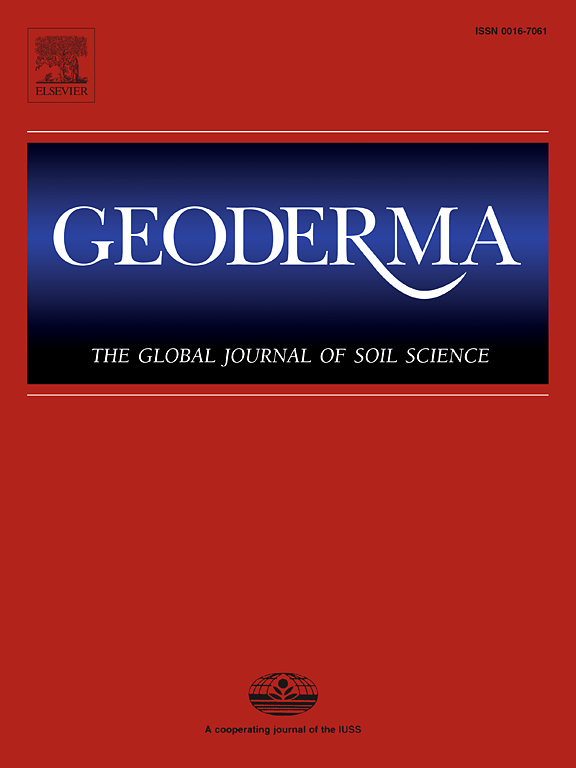Using soil classification to improve interpretation of biological soil health indicators
IF 5.6
1区 农林科学
Q1 SOIL SCIENCE
引用次数: 0
Abstract
The concept of soil health recognizes soil as a living and dynamic natural system, a notion that aptly fits in the realm of biology. However, soil health tests and scoring tools are often dominated by indicators other than soil biology, such as soil fertility and chemistry. Biological indicators of soil health remain understudied and underrepresented in soil health assessments. To address this gap, here we evaluate soil attributes that reflect biological functions and vitality (including organic and total C, total N, mineralized C, extracellular enzyme activity, and phospholipid fatty acid (PLFA) analysis for microbial biomass and adaptation response ratio (ARR)). We assess if these biological indicators can be contextualized by soil classification and measure their responsiveness to agricultural management practices in Prairie region of Saskatchewan Canada. Despite the dynamic nature of biological indicators of soil health, we find that soil classification by great group constrains measurements and serves as a useful contextualizing factor to adjust scoring functions. Further, we find biological indicators of soil health (namely soil organic C, total N, and P and S enzyme activity) generally improve with more regenerative crop production practices such as cover cropping or organic management. Although other indicators such as CO2 mineralization, N and C cycling enzymes, PLFA and ARR showed fewer differences among crop production practices, all were greater under prairie grassland than cropland. In contextualizing soil health scores by soil classification and including biological indicators of soil health that embody soil pools, processes, and life, soil health assessments will not only better represent soil biology and appropriately contextualize soil health scores, but also move towards better targeting soil functioning and vitality.
利用土壤分类改进对土壤健康生物指标的解释
土壤健康的概念认为,土壤是一个有生命的动态自然系统,这一概念恰好与生物学领域相吻合。然而,土壤健康测试和评分工具往往以土壤生物学以外的指标为主,如土壤肥力和化学指标。土壤健康的生物指标在土壤健康评估中的研究和代表性仍然不足。为了弥补这一不足,我们在此评估了反映生物功能和活力的土壤属性(包括有机碳和总碳、总氮、矿化碳、细胞外酶活性以及微生物生物量和适应反应比磷脂脂肪酸分析)。我们评估了这些生物指标是否可以通过土壤分类进行背景分析,并测量了它们对加拿大萨斯喀彻温省草原地区农业管理措施的响应程度。尽管土壤健康的生物指标具有动态性,但我们发现,按大类进行的土壤分类会限制测量结果,并可作为一个有用的背景因素来调整评分函数。此外,我们还发现,土壤健康的生物指标(即土壤有机碳、全氮、磷和硒酶活性)通常会随着覆盖种植或有机管理等更具再生性的作物生产实践而得到改善。虽然二氧化碳矿化度、氮和碳循环酶、PLFA 和 ARR 等其他指标在不同作物生产方式下的差异较小,但在草原草地上的差异均大于耕地。通过土壤分类确定土壤健康评分的背景,并纳入体现土壤池、过程和生命的土壤健康生物指标,土壤健康评估不仅能更好地代表土壤生物学并适当确定土壤健康评分的背景,还能更好地针对土壤功能和活力进行评估。
本文章由计算机程序翻译,如有差异,请以英文原文为准。
求助全文
约1分钟内获得全文
求助全文
来源期刊

Geoderma
农林科学-土壤科学
CiteScore
11.80
自引率
6.60%
发文量
597
审稿时长
58 days
期刊介绍:
Geoderma - the global journal of soil science - welcomes authors, readers and soil research from all parts of the world, encourages worldwide soil studies, and embraces all aspects of soil science and its associated pedagogy. The journal particularly welcomes interdisciplinary work focusing on dynamic soil processes and functions across space and time.
 求助内容:
求助内容: 应助结果提醒方式:
应助结果提醒方式:


